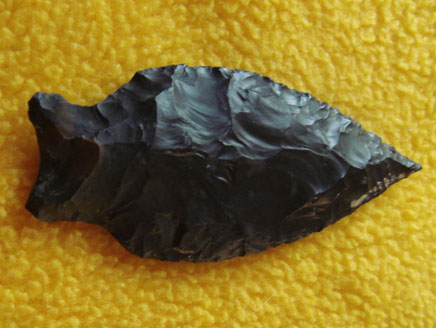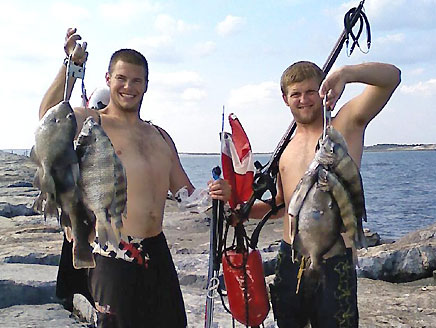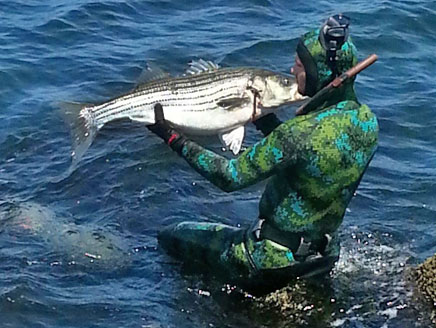

Spearfishing may be one of our oldest methods of putting food on the table...but it is now grabbing attention due to a new breed of dedicated and skillful anglers!
Photos and Story by Bob Misak
Age old methods carry on...
In days of old,(and by old I mean way back when the Lenni-Lenape tribe of Indians walked our shorelines in search of food ), the spear was a vital instrument. Spears were not only for taking many types of game, but for spearing fish as well. The Lenni-Lenape were seasoned fishermen and hunters. Their survival depended on it. They used giant nets strung up to a mile along our shorelines, called fish weirs. These were similar to the seine net that many bait catching fishermen use today, only it wasn't pulled along. The net was strung along the banks of our bays and rivers, and small openings were periodically set in the netting, allowing fish to enter. When the Lenni-Lenape saw the net fill to a comfortable capacity, the holes would be sealed and these Early American anglers would get inside, spearing any fish that were trapped in the weir. This was a meticulous and well though out process. The fish were immediately cleaned and processed right there on site by the women of the tribe. There would be smokehouses set up and the fish were smoked and processed quickly. The smoked and prepared product was much lighter, making it easier to transport back to their living quarters deep in the cover of the woods, far from the water's edge. This was an amazing display of food preparation and storage, and the local Indians mainly processed shad, which were found in huge numbers in the Delaware and Barnegat Bays. Today, the tradition of taking fish by spear still exists; but by no means is it what it used be. Time and technology have made spear fishing one of the most intriguing methods of fishing out there, and some have mastered it as well as those early Americans did back in 1700's.. with a little help from technology.
 |
| This early Native American spear head came from the tongs of a clammer in Barnegat bay, and it is in remarkably pristine condition given its ancient heritage. |
Basics of the sport...
To take the sport of spear fishing seriously, one must obviously think seriously, as there is quite a bit to take into consideration. I have a cousin who is as serious as it gets when it comes to taking fish by spear. Adam Sprague, who is a biology instructor for the M.A.T.E.S. Academy in Manahawkin, New Jersey, was born and raised with the spear. He bought his first spear gun when he was around 8 years old. Adam and his father Jim have spent most of their lives in the Florida Keys, and Adam was a veteran spear gunner when most anglers didn't even have their first fishing rod yet.
With the spear, Adam took many types of fish in his early years and continues to do so today. His co-worker, fellow teacher Brian Cohen, also took up the sport a few years back, and these two are two of the most dedicated spear fishers out there. Brian has, to date, posted quite a resume when it comes to spearing fish. He has taken a 40 pound striper by spear and has also taken a 20 pound fluke. These are the type of fish that anglers dream of taking by rod and reel, but Brian has done it with a spear gun. Both he and Adam are in the circle of the more knowledgeable and seasoned gunners out there.
However, the sport of spearfishing is growing. Today, many more anglers are raising an eyebrow at the prospect of jumping into the water and fishing, while swimming amongst the very fish they are after. Mark Guenther is another seasoned veteran of the sport as well, diving most jetties along the shores of New Jersey that you are permitted to dive. Mark is sponsored by the Dive site Slingfish.com and also has sponsorship by Atlantic Dive and Scuba in Point Pleasant. The shop specializes in the new carbon-fibred technologies that make spear fishing a solid, successful sport, as compared to the past "Hawaiian sling" methods of old. New age gear and the science of water clarities, as well as the using of weights and better insulated suits has put some comfort into the sport of taking fish by spear, and Mark Guenther and his boys have mastered it!
 |
| Aaron Cipoletti and Ryan Rickmer show off a mixed bag of triggers, sheepsheads, and tog, all taken by spear around the jetty rocks. |
This is NOT for the faint of heart...
Taking a fish with a spear is not a sport for everyone. It takes a fairly agile, healthy body for one to spear fish, and holding your breath for extended periods of time is going to be first and foremost in the experience department. Most spear gunners fish inshore, using the jetty rocks and the endless supply of many different species of fish to master their trade. However, some really, really serious spear gunners will go offshore, using tanks to dive in a hundred feet of water or more, spearing everything from big tautog to giant fluke, and some even go the distance. There they can even spear faster fish like mahi-mahi, depending on their years on the water, or "under it". At any rate, inshore spear fishing is a great way to start, if you have a healthy set of lungs and some good arms and legs for swimming. This is the reason that a lot of spear fishers are surfers. Most have not only been around the water all of their lives, but they've been in the water as well. According to the best of them, being in the water all the time seasons them for the dive and it made it easier for them to learn.
Lots of equipment
To take spear fishing seriously, it is recommended that you go out with a spear fisherman and have him teach you the basics... the first being equipment and safety. Diving off of the jetties is not without danger. Discarded fishing line and sharp rocks are the enemy, and a dive knife is probably your most important item. It will cut you out of an underwater emergency, like getting tangled in a ball of braid or having the lines to your spear getting tangled on structure. The dive knife should never be forgotten, and always right on your buckle at your disposal. Though some brave jetty divers wear no wet suit during the height of summer when the water temps are in the 80’s, a suit of some type is recommended for protection from sharp edges of rocks or discarded debris such as glass or fish hooks. Wet suits from 3 to 5 millimeters in thickness are the most commonly used here at the shore. Remember, the colder the water, the thicker the suit you should have. Typically, the 3 mil suits are used in warmer waters; the 5 mil suits can be used as the water cools. With that, weight belts will also be needed. As the spear guys relate, the thicker the suit, the more weight you’ll need. With that comes body size; the bigger the man, the more weight needed to get you down to what a diver calls “neutral buoyancy”. This is the depth that you find comfortable to move along slowly and spot and spear fish. You’ll need a swim buoy, which hangs from your suit with a float attached, for identifying that you are in the water as well as keeping you at a comfortable depth. The length of the line on your swim buoy is dictated by the depth of the water you’ll be diving in. And you should always have a dive flag, which is the law, in a visible area to boaters. This is red flag with a white diagonal strip running through it, and all boaters should know what this flag signifies. There is a man in the water, and you should completely avoid that area. Spear guns are the last item in your arsenal, though it seems as though they should be the first. The gun is last... spear fishing safety ALWAYS comes first.
 |
| Mark Guenther pulls a nice striper from South Jersey's waters...taken by spear. |
Underwater eyes...
When you have completed your basic training on the "safety" part of taking fish by spear, that's when the cost comes in. Wetsuits aren't cheap, and it might cost up to 700 or 800 dollars to get a suit, a buoy and flag, a weight belt, swim fins, knife, mask, snorkel and a gun. Spear guns are variable; they start at 250 or 300 dollars, and can go up to a thousand dollars or more, depending on quality. A lot of guys will use a gun made by the A.B. Biller Company, as they have a fairly inexpensive model that you can start with until you find out if spear fishing is something you want to pursue. Some old time spear fishermen use an old method called a Hawaiian sling, which is basically a giant, loaded rubber band that shoots the spear. But most spear gunners of today use the load-type projectile shooter, as it is much more practical and modern when it comes to sneaking in on and shooting fish quickly. Once you have practiced holding your breath for extended periods of time, (and some seasoned spear guys can stay under for up to 5 full minutes) you are ready for the underwater world of spear fishing.
Different obstacles to overcome
Here in the northeast, there is one major obstacle to overcome when fishing by spear...visibility. The visibility is limited here in the northeast. Clear water is hard to come by, especially inshore. When tides run out and get low, silt and mud is lifted from the bottom and clouds the water on each tide. When the tide comes back in, you can many times see the clear water line separated from the cloudy water, while on land. A spear fisher has to find that clear window to see fish on the bottom, and it is very limited. In 10 or 12 dive trips, a diver may only get optimum clarity once or twice. These are the days when success is the greatest. While 6 to 8 feet of visibility is the minimum that most guys will dive in, on a good day you can get up to 15 or 20 feet. Another obstacle to overcome is fish size, since fish look larger underwater. Remember, spear fishermen have the same set of rules as guys up on top. Just about all the spear guys I know will only shoot at a fish that is grossly over-sized underwater. This policy ensures that you don't spear any short fish, also avoiding the usual fines that would come along with it. As Adam said it me, "There is no catch and release with the spear, only catch". With that said, it's very important to know about how many inches are 18 when fluking, 28 when striper fishing, and so on. The other thing to remember once you're in the water, is where to hit that fish. When fishing for large fish, a head shot is very important. A body or stomach shot into the soft part of a large fish can, and will, likely result in a lost fish. When spearing smaller fish like triggers and smaller togs, a body shot will hold the fish until you "bag it".
Getting along...
The final part of the spear fishing game is etiquette. I have seen some gnarly arguments come about by the guys on land or boaters versus the spear gunners. I fish up top a lot on the jetties, and when I see a spear fisherman drifting down towards me, I never panic. A lot of anglers curse and yell, and blame the spear guy for running fish off. This is the farthest thing from the truth. I pull my rig, and let the spear guy go by. The truth is that togs and fluke will just swim off a few feet, or back into the rocks to avoid detection. You must remember that a spear guy has limited mobility, usually hugging the rock pile to stay out of swift currents. You being up top, however, can cast, and fish don't stop feeding just because a spear fisherman swims by. I wait a couple minutes, take a short break, and sure enough I begin catching fish again right after they go through. And the best part is this... spear fishermen are indeed, the eyes of the sea. I haven't met a spear guy yet who doesn't tell me exactly where concentrations of fish are. They will point out a large rock with a small eddy circling around it and tell me, "That eddy is full of bass". Or they will show me a certain rock and say, "This is where all the togs are balled up". I will then take their advice and go over and catch some of those fish. But one thing that the spearfishers tell me they see sticks out in my mind. the beauty of a world that hardly anyone gets to see up close and personal. So if you want to try your hand at some spear fishing, think it over hard before you spend, make sure to check the area you want to fish to make sure spear fishing is permitted, and try to find a "spear fishing friend"... someone who will guide you along until you can go out on your own. Now those of you who may be fishing up top, be courteous... and all you have to do is ask. The spear guys will let you know where you're supposed to be fishing.
Good luck and great fishing!














